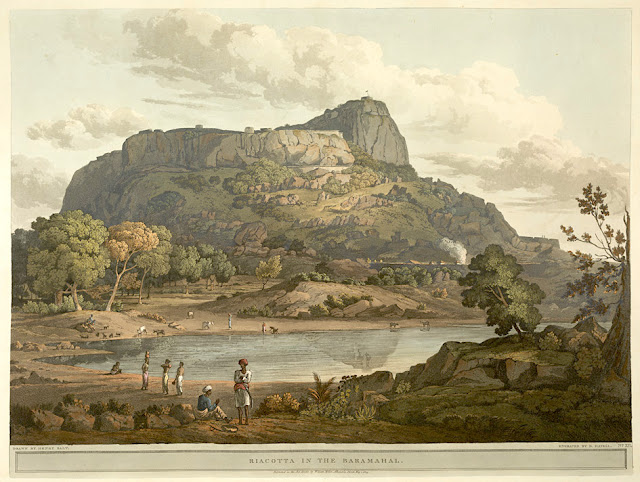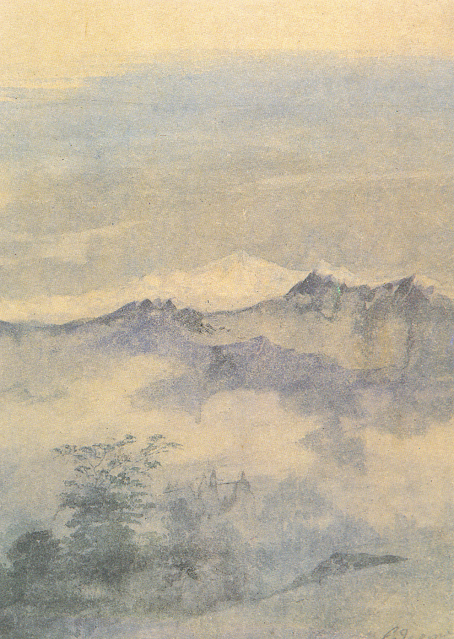F. W.A. DE FABECK (1830-1912)
Kangchenjunga (8 586m)
Inde - Népal
In Kintchindjinga Peaks seen from Jelapahar (India) 1890, Victoria & Albert Museum, Londres
La montagne
Le Kangchenjunga (8586m) (appelé aussi Kanchenjunga, Kangchen Dzö-nga, Kachendzonga, Kintchindjingaou Kangchanfanga) est un sommet de l'Himalaya, sur la frontière indo-népalaise, à l'est du Népal, entre le district de Taplejung et l'État indien du Sikkim où il peut être vu notamment de la capitale Gangtok. Son altitude le classe troisième sommet sur Terre, après l'Everest et le K2, et fait du Kangchenjunga le point culminant de l'Inde. Jusqu'en 1852, il fut considéré comme le plus haut sommet du monde. Le Kangchenjunga est plus qu’un sommet, il forme toute une chaîne de sommets satellites reliés entre eux par des arêtes enneigées ou glacées qui se déploient vers le sud. Malgré sa signification, il ne comporte que quatre sommets majeurs : le sommet sud (8 490 m), le sommet central (8 496 m), le sommet principal au nord (8 586 m), qui est relié au sommet Ouest ou Yalung Kang (8 505 m). À la base de la face est débute le glacier de Zemu, plus grand glacier de l'est de l'Himalaya. Le Kangchenjunga est au centre du massif éponyme situé à cheval entre le Népal et l'Inde (Sikkim). La ligne de crête principale, orientée nord-sud, constitue la frontière entre les deux pays. Les sommets de cette crête sont : le pic Langpo (6 958 m), le Pathibara (7 123 m), le Kirat Chuli (7 365 m), le pic Népal (7 177 m), le Gimmigela Chuli (7 350 m) et le Kabru (7 412 m).
Côté népalais, a été créée l'aire de conservation de Kanchenjunga avec le Drohmo (6 881 m), le Ramthang Chang (6 802 m), le Kangbachen (7 902 m) et le Jannu (7 771 m). Le parc national de Khangchendzonga au Sikkim a comme principaux sommets non frontaliers le Siniolchu (6 888 m), le Simvo (6 812 m) et le Pandim (6 691 m).
En 1848, le colonel Andrew Waugh mesure le Kangchenjunga à 28 178 pieds (8 588 m), qui semble légèrement plus haut que les mesures du Dhaulagiri, qui, lui, était le plus haut sommet avant le calcul du Kangchenjunga.
L'artiste
Les frères Frederick William Alexander de Fabeck (1830-1912) et William Frederick de Fabeck (1834-1906) étaient tous deux employés dans le service médical indien. Frédéric-Guillaume est né le 15 septembre 1830 et a étudié à Paris. Il est devenu licencié du Royal College of Surgeons d'Édimbourg en 1858, année au cours de laquelle il a été nommé chirurgien adjoint du service du Bengale. Il mourut à Alassio, en Italie, le 5 mai 1912. William Frederick devint chirurgien adjoint du service de Madras en 1857, chirurgien en 1869, chirurgien major en 1873 et chirurgien de brigade en 1882. Ses croquis, principalement des détails architecturaux, ont probablement été réalisé, lorsqu'il fut affecté à Jaipur comme professeur à l'École d'Art avant d'en devenir le directeur. Il a également préparé les plans de l'exposition de Jaipur de 1883. Il a servi en Crimée (1854-1855) et participa au siège et à la prise de Sébastopol. Il mourut à Londres le 18 janvier 1906.
______________________________________
2024 - Gravir les montagnes en peinture
Un blog de Francis Rousseau
_%20Kinchinpanga%20Peaks%20seen%20from%20Jelapahar%20(%20India)%201890-%20V&A%20Museum.jpg)
















